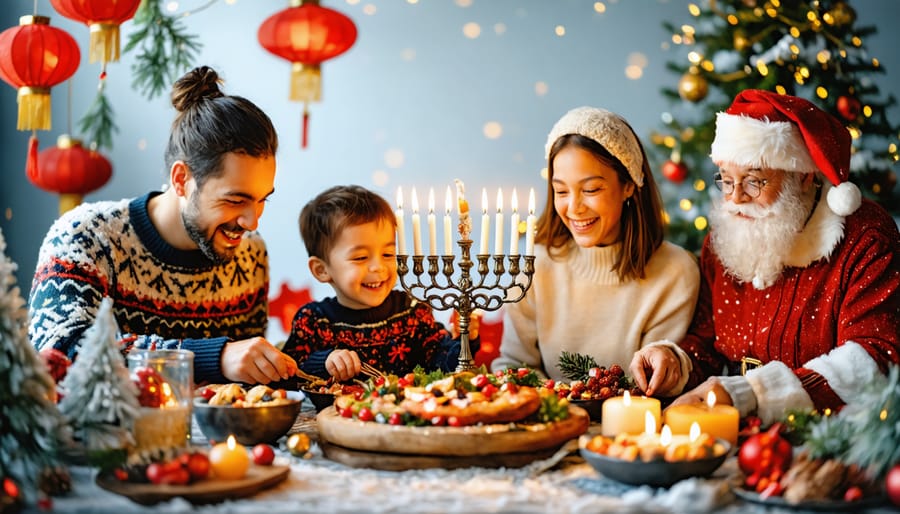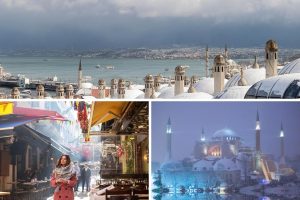As snowflakes drift across continents, magical winter traditions unite families in a tapestry of celebration that spans cultures, generations, and borders. From the glow of menorah candles in Jewish homes to the vibrant Lunar New Year festivities across Asia, winter’s embrace inspires humanity’s most cherished rituals of togetherness and joy.
In homes perched high in the Swiss Alps, families gather around bubbling pots of cheese fondue, while in Mexico, children anticipate the arrival of the Three Kings with the same sparkle in their eyes as Swedish children awaiting Santa Lucia’s crown of candles. These celebrations, though diverse in their customs and origins, share a common thread: the human desire to illuminate the darkest season with light, love, and tradition.
Whether it’s the rhythmic beat of drums during Japanese Omisoka ceremonies or the sweet aroma of freshly baked Christmas cookies wafting through American homes, winter holidays remind us that despite our differences, the warmth of celebration transcends all boundaries. Join us on a journey through these time-honored traditions that transform the coldest months into the world’s most heartwarming season.
European Winter Wonderland
St. Nicholas Day in Germany and Netherlands
As December 6th approaches, children across Germany and the Netherlands eagerly anticipate the arrival of St. Nicholas, known as “Sankt Nikolaus” in Germany and “Sinterklaas” in the Netherlands. On the evening of December 5th, children carefully polish their boots or shoes and place them by the front door or window sill, hoping to find them filled with treats the next morning.
Legend has it that St. Nicholas travels by horseback through the night, accompanied by his helper Krampus in Germany or Zwarte Piet in the Netherlands. Good children wake to find their shoes brimming with chocolates, cookies, small toys, and traditional speculaas cookies. Sometimes, oranges or mandarins are included as special treats, hearkening back to the days when citrus fruits were rare winter luxuries.
In many German and Dutch communities, someone dressed as St. Nicholas visits schools and homes, wearing his distinctive red bishop’s robe and carrying his golden staff. Children sing traditional songs and recite poems, and St. Nicholas consults his golden book to tell them whether they’ve been good throughout the year. This beloved tradition marks the beginning of the magical winter holiday season for many families.
Swedish Santa Lucia Festival
In the heart of Swedish winter darkness, a magical celebration brings warmth and light to the coldest days of December. The Festival of Santa Lucia, one of the most enchanting Swedish winter celebrations, illuminates homes and churches across the country on December 13th. Young girls dressed in flowing white gowns, adorned with red sashes, process through dimly lit halls wearing crowns of glowing candles. Leading the procession is Lucia herself, spreading hope and light in the darkness.
The air fills with the sweet aroma of saffron-flavored Lussekatter (Lucia buns) and pepparkakor (gingerbread cookies), while traditional songs echo through the morning darkness. Children and adults alike gather to watch as the Lucia procession serves coffee, treats, and brings the promise of brighter days ahead. This beautiful tradition, blending Christian celebration with ancient Nordic customs, reminds us that even in the darkest times, light and warmth prevail through community and celebration.
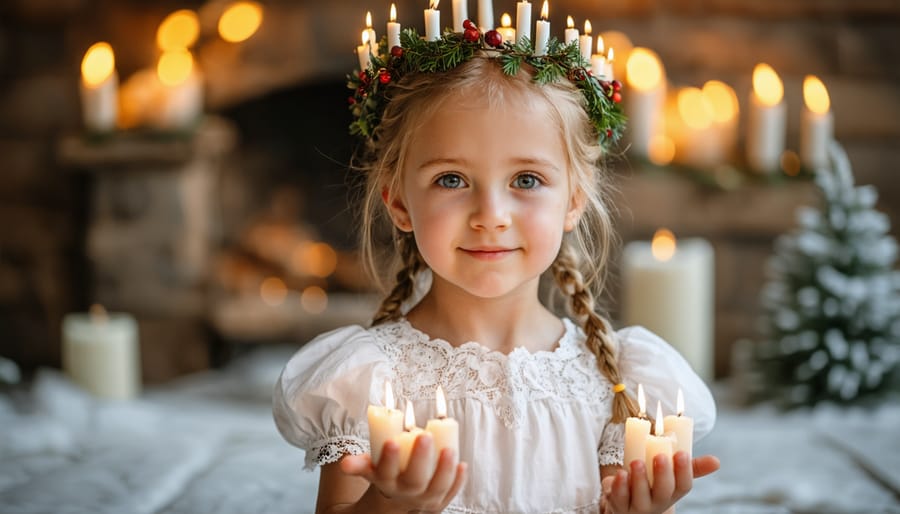
Christmas Markets of Austria and Switzerland
Step into a winter wonderland where twinkling lights dance across cobblestone streets and the sweet aroma of roasted chestnuts fills the crisp mountain air. Austria and Switzerland’s Christmas markets transform historic town squares into enchanted villages from late November through December. In Vienna’s Rathausplatz and Zurich’s Christkindlimarkt, wooden chalets adorned with evergreen garlands showcase handcrafted ornaments, delicate glass decorations, and traditional toys.
Visitors warm their hands around steaming mugs of Glühwein (mulled wine) while children’s eyes sparkle at the sight of chocolate-covered fruits and freshly baked Lebkuchen. Local artisans demonstrate centuries-old crafts, from glass-blowing to candlemaking, keeping beloved traditions alive. As darkness falls, the markets come alive with carol singers and the gentle chiming of church bells, creating a magical atmosphere that captures the true spirit of an Alpine Christmas.
These markets aren’t just shopping destinations; they’re gathering places where families and friends come together to celebrate the season’s joy, carrying on traditions that have delighted generations.
Asian Winter Festivities
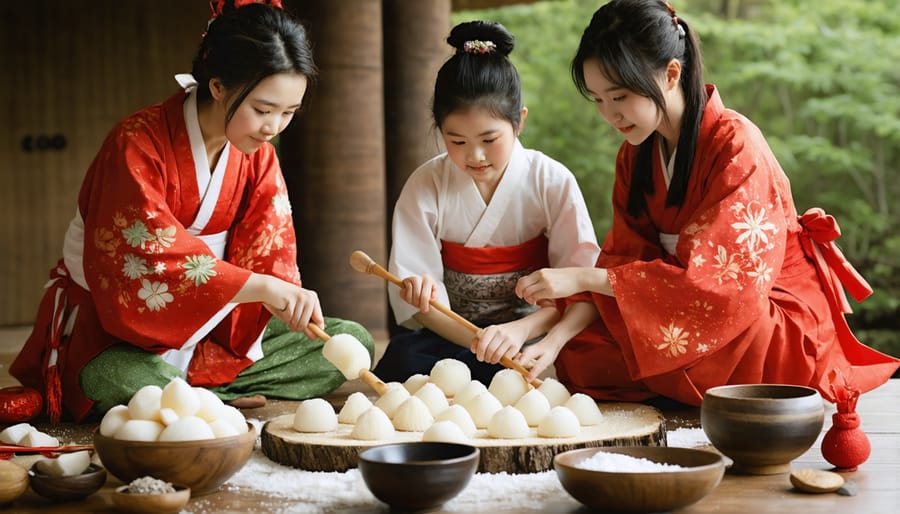
Japanese New Year Traditions
As the first rays of sunlight grace Japan on January 1st, families gather to celebrate Oshogatsu, the most significant holiday in the Japanese calendar. The festivities begin with the enchanting sound of temple bells ringing 108 times at midnight, a ritual known as Joya no Kane, symbolically cleansing away the troubles of the past year.
Homes transform into welcoming spaces adorned with traditional decorations. Fresh bamboo and pine arrangements called kadomatsu stand guard at doorways, inviting good fortune, while shimenawa ropes with zigzag paper streamers ward off evil spirits. Inside, families display kagami mochi, rounded rice cakes topped with a bright orange, representing hopes for a prosperous year ahead.
The first breakfast of the year, osechi ryori, is a feast for both eyes and palate. Elaborate boxes called jubako contain carefully prepared dishes, each with special meaning: sweet black soybeans for health, herring roe for fertility, and golden chestnuts for wealth. Children eagerly await otoshidama, small envelopes containing money gifts from their elders, while adults share cups of warm sake and heartfelt wishes.
Many Japanese families dress in their finest kimono and visit local shrines for hatsumode, the first prayer of the year. The air fills with the sweet scent of amazake, a warm, non-alcoholic rice drink, as people gather to write their wishes on small wooden plaques called ema, hanging them with hope and anticipation for the year ahead.
Chinese Winter Solstice Festival
As winter’s darkest day approaches, families across China gather to celebrate Dong Zhi, the traditional Winter Solstice Festival that has warmed hearts for over 2,000 years. This cherished celebration marks the gradual return of longer days and serves as a reminder of nature’s eternal cycles.
The festival’s centerpiece is the beloved tradition of making and sharing tang yuan, small round dumplings made from glutinous rice flour floating in sweet soup. These perfectly formed spheres symbolize family unity and completeness, with their round shape representing harmony and togetherness. Children delight in helping their elders roll the colorful dough into tiny balls, creating memories as sweet as the dessert itself.
In northern China, families gather to make and eat warming dumplings filled with minced meat and vegetables, while southern regions favor the sweetness of tang yuan. The preparation of these festive treats becomes a joyful family activity, with generations working side by side, sharing stories and passing down time-honored techniques.
Beyond the culinary traditions, Dong Zhi is a time for expressing gratitude and paying respects to ancestors. Families visit temples together, light incense, and make offerings to honor those who came before them. The festival emphasizes the importance of family bonds and the passing of traditional values from one generation to the next, creating a warm atmosphere of love and remembrance during the cold winter days.
Festive Traditions in the Americas
Las Posadas in Mexico
As the December nights descend upon Mexico, a beautiful tradition illuminates the streets and warms hearts. Las Posadas, meaning “the inns” in Spanish, recreates Mary and Joseph’s search for shelter before Jesus’s birth through a nine-day celebration from December 16th to 24th.
Each evening, candlelit processions wind through neighborhoods, with children dressed as angels, shepherds, and the Holy Family. Two young people portray Mary and Joseph, leading the gathering as they visit designated houses, singing traditional songs that ask for shelter. The hosts initially turn them away, following the scriptural story, until finally welcoming them with open arms.
Once inside, the celebration truly begins. Families and neighbors gather to share traditional treats like buñuelos (crispy fried dough drizzled with syrup), ponche navideño (a warm fruit punch), and tamales. Children eagerly await their turn to break the piñata, which traditionally has seven points representing the seven deadly sins. The star-shaped piñata, when broken, showers guests with candies and small toys, symbolizing the triumph of faith over sin.
The atmosphere buzzes with joy as people share stories, sing villancicos (Christmas carols), and strengthen community bonds. Each night builds anticipation for Nochebuena (Christmas Eve), when the final Posada culminates in midnight Mass and a grand feast, uniting families in cherished tradition and festive celebration.
Canadian Winter Festivals
In the heart of the Canadian winter, vibrant festivals light up the snow-covered landscape, transforming the chilly season into a magical celebration of culture and community. The Quebec Winter Carnival, one of North America’s largest winter festivals, brings the streets of Quebec City alive with ice sculptures, snow slides, and the beloved mascot Bonhomme – a cheerful snowman wearing a traditional red cap and arrow sash.
Across the country, Canadians embrace the cold with infectious enthusiasm. In Ottawa, the Winterlude Festival transforms the Rideau Canal into the world’s largest skating rink, where families glide along the ice while savoring warm beaver tails – a beloved Canadian pastry dusted with cinnamon and sugar. Children’s laughter echoes through ice castles as they marvel at intricate sculptures that glisten in the winter sun.
The Vancouver Winter Wonderland celebrates the season with a unique West Coast flair, combining holiday lights with rainforest scenery. In Toronto, the Cavalcade of Lights illuminates Nathan Phillips Square, while the Christmas Market in the Distillery District recreates the charm of European holiday markets with a distinctly Canadian twist.
Indigenous communities share their winter traditions through powerful storytelling and ceremonies, while small towns host charming winter festivals featuring dog sledding, maple taffy pulling, and traditional music. These celebrations remind us that Canadian winters, though cold, warm hearts through community spirit and shared joy.
Winter Holiday Foods Around the Globe
Traditional Christmas Feasts
Around the world, families gather to share heartwarming holiday meals that have been passed down through generations, making Christmas festivities truly magical. In England, the traditional feast centers around a golden-brown roasted turkey, accompanied by crispy roast potatoes, Brussels sprouts, and the beloved Yorkshire pudding, all crowned with rich gravy and cranberry sauce.
Venture to Australia, where families often enjoy a sunny Christmas barbecue on the beach, featuring fresh seafood, particularly prawns and lobster, alongside refreshing pavlova decorated with summer fruits. In Germany, the traditional Christmas goose takes center stage, served with red cabbage, dumplings, and the sweet aroma of freshly baked stollen wafting through homes.
Italian families celebrate with the Feast of the Seven Fishes on Christmas Eve, a beloved tradition featuring an array of seafood dishes. Meanwhile, in the Philippines, families gather for Noche Buena, enjoying lechon (roasted pig), queso de bola, and sweet purple rice cake called puto bumbong.
In Sweden, the julbord (Christmas table) showcases pickled herring, meatballs, and the traditional rice pudding with an almond hidden inside – finding it means good luck for the coming year. Each of these festive meals not only satisfies hunger but also brings families together, creating cherished memories that last a lifetime.
Special Holiday Treats and Sweets
The aroma of freshly baked treats wafting through homes during the winter holidays is a cherished part of celebrations worldwide. In Germany, families gather to bake Stollen, a fruit-studded bread dusted with powdered sugar that symbolizes the swaddled Baby Jesus. Italian tables sparkle with golden Panettone, a dome-shaped sweet bread that rises for days to achieve its ethereal texture, while children eagerly await the arrival of crunchy Biscotti perfect for dunking in hot chocolate.
In Mexico, families share Pan de Muerto during Día de los Muertos, its sugar-dusted surface decorated with dough “bones” representing the circle of life. The scent of cardamom fills Scandinavian kitchens as saffron-tinted Lussekatter buns, shaped like curled cats, are prepared for St. Lucia Day. Jewish families celebrate Hanukkah with golden, crispy Sufganiyot, jelly-filled doughnuts that commemorate the miracle of the oil.
Russian homes welcome guests with Pryaniki, spiced honey cookies often elaborately decorated to tell stories of winter festivities. In the Philippines, purple Ube Halaya sweetens Noche Buena celebrations, while British families traditionally stir up Christmas puddings, making wishes as they mix the batter filled with dried fruits and warming spices. These beloved treats do more than satisfy sweet cravings – they carry centuries of tradition, connecting generations through the simple joy of sharing something delicious during the coldest, darkest days of winter.
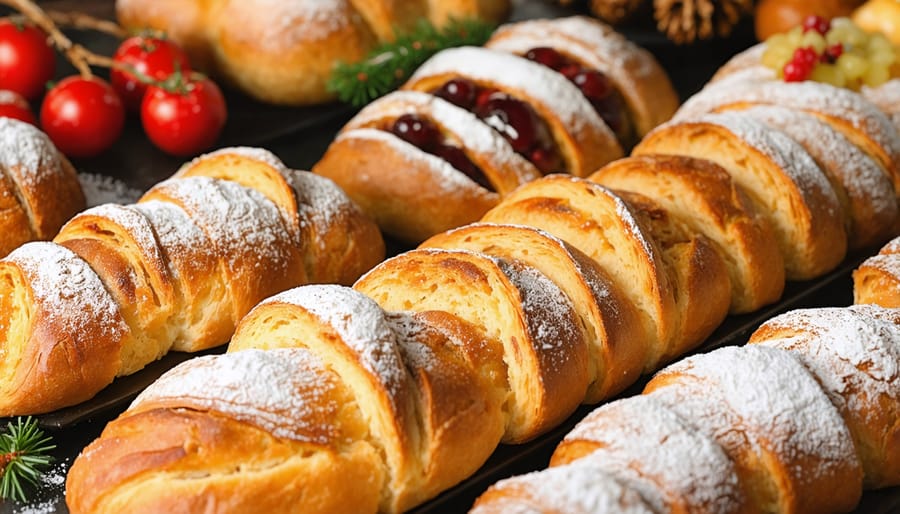
As winter blankets our world in glistening snow, it’s remarkable how diverse cultures across the globe embrace this magical season with their own unique holiday traditions. From the flickering lights of Hanukkah menorahs to the vibrant lanterns of Chinese New Year, each celebration adds a distinct thread to the tapestry of global winter festivities. These cherished customs do more than mark the calendar; they weave families closer together, creating precious memories that span generations.
Whether it’s gathering around a crackling fire to share stories in Norway, preparing tamales as a family in Mexico, or lighting advent candles in Germany, these winter rituals remind us that the true essence of the season lies in togetherness. The warmth of these celebrations transcends cultural boundaries, teaching us that despite our differences, we all share the universal desire to connect, celebrate, and find light in the darkness of winter.
As we embrace our own traditions while learning about others, we discover that the beauty of winter celebrations lies not just in their individual customs, but in how they collectively illuminate the human spirit. In homes across the world, these precious moments of joy, reflection, and unity continue to brighten the coldest months, proving that winter’s magic knows no borders.


